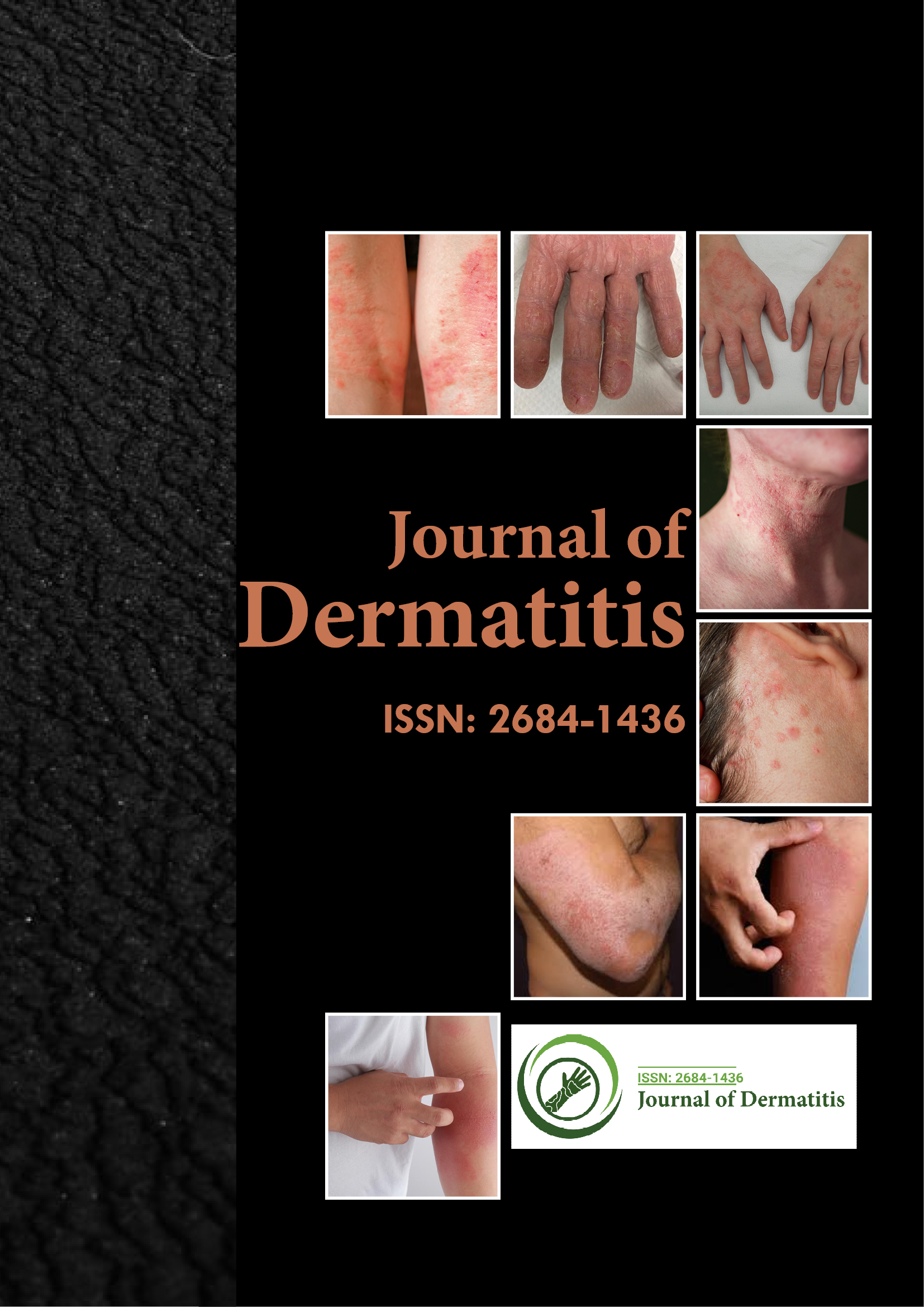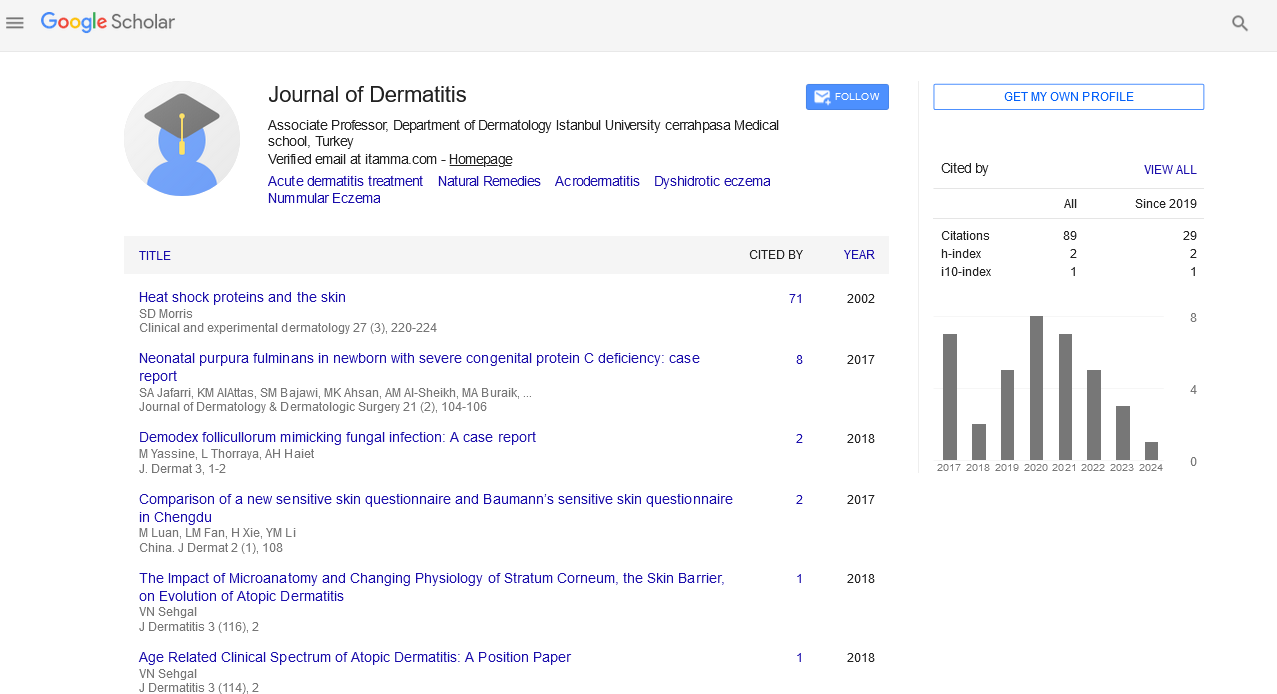Indexed In
- RefSeek
- Hamdard University
- EBSCO A-Z
- Euro Pub
- Google Scholar
Useful Links
Share This Page
Journal Flyer

Open Access Journals
- Agri and Aquaculture
- Biochemistry
- Bioinformatics & Systems Biology
- Business & Management
- Chemistry
- Clinical Sciences
- Engineering
- Food & Nutrition
- General Science
- Genetics & Molecular Biology
- Immunology & Microbiology
- Medical Sciences
- Neuroscience & Psychology
- Nursing & Health Care
- Pharmaceutical Sciences
Commentary - (2024) Volume 9, Issue 1
Psoriasis Dynamics: Understanding Cellular Mechanisms for Enhanced Treatment
Thanin Shike*Received: 02-Mar-2024, Manuscript No. JOD-24-26012; Editor assigned: 05-Mar-2024, Pre QC No. JOD-24-26012 (PQ); Reviewed: 21-Mar-2024, QC No. JOD-24-26012; Revised: 27-Mar-2024, Manuscript No. JOD-24-26012 (R); Published: 05-Apr-2024, DOI: 10.35248/2684-1436.24.9.229
Description
Millions of individuals worldwide suffer with psoriasis, a chronic inflammatory skin disorder that significantly lowers quality of life. Extensive research has revealed the complex interplay of molecular and cell-mediated mechanisms in the epidemiology of psoriasis, even if the exact origin of the condition is still unknown. Comprehending these pathways is essential for creating efficient therapies and approaches for handling this intricate illness.
The sign of psoriasis is the abnormally fast growth of skin cells, which causes thick, scaly plaques to appear on the skin's surface. Immunological dysregulation is closely associated with this process, and the pathophysiology of disease is significantly influenced by both innate and adaptive immunological responses. Psoriasis vulgaris, the most prevalent type of psoriasis, is usually linked to an excessive T-cell response.
One biological route which genetic factors significantly contribute to psoriasis is genetic predisposition. A family history of the illness is recognized as a risk factor, and numerous genes have been found to be involved. For example, there is a substantial correlation between psoriasis susceptibility and the HLA-Cw6 allele. Psoriatic lesions might arise as a result of these genetic predispositions influencing the expression of different cytokines, immunological receptors, and cell surface chemicals.
One of the biological pathways through which dysregulated cytokine signaling is a characteristic of psoriasis is cytokines and inflammation. The inflammatory response is primarily driven by three important players: interleukin-17 (IL-17), interleukin-23 (IL-23), and tumor necrosis factor-alpha (TNF-α). These cytokines encourage keratinocytes in the skin to become activated and proliferate, which results in the recognizable psoriatic plaques. By modifying these molecular pathways, targeted medicines like IL-17/IL-23 blockers and TNF-α inhibitors have completely changed the way psoriasis is treated.
One of the biochemical pathways by which aberrant keratinocyte proliferation is a key characteristic of psoriasis is keratinocyte hyper proliferation. Excessive keratinocyte proliferation is caused by dysregulated signaling pathways, such as the Nuclear Factor Kappa B (NF-κB) and Mitogen-Activated Protein Kinase (MAPK) pathways. Furthermore, it has been suggested that the Janus Kinase-Signal Transducer and Activator of Transcription (JAKSTAT) pathway mediates cytokine signaling in psoriatic skin. Psoriatic symptoms can be reduced and hyper proliferation managed by using drugs that target these pathways.
The infiltration of activated T-cells into the skin is one of the Cell-Mediated Pathways, or T-cell activation, that characterizes psoriasis. These T-cells, in particular Th17 and Th1 cells, contribute to the inflammation and keratinocyte proliferation observed in psoriasis lesions by producing pro-inflammatory cytokines such as IL-17 and Interferon-Gamma (IFN-γ). Biologics and other immune-modulating therapies aim to reduce inflammation by inhibiting T-cell activation and cytokine production.
One of the cell-mediated pathways in psoriasis is the dendritic cell, which plays a crucial role in delivering antigens to T-cells and initiating the immunological response. Because they can produce type I interferons, plasmacytoid Dendritic Cells (pDCs) have been linked to the pathophysiology of psoriasis. Potential treatment techniques now center on targeting these cells or their activity.
Neutrophils are a component of the cell-mediated pathway; they are seen in large quantities in psoriatic lesions and worsen inflammation. They contribute to tissue injury by releasing reactive oxygen species and inflammatory mediators. IL-17 is one of several cytokines that carefully regulates the recruitment and activation of neutrophils. Comprehending this facet of the illness may result in innovative approaches to therapy that manage neutrophil activity.
In summary, psoriasis epidemiology is a result of the intricate interaction between cell-mediated and molecular processes. The pathophysiology of the disease is primarily driven by immune cell activation, cytokine dysregulation, and genetic predisposition. Psoriasis treatment has undergone a revolutionary change to the introduction of customized medicines resulting from advances in our understanding of these pathways. In order to find novel therapeutic targets and improve upon already available treatment options, further study into the precise mechanisms behind psoriasis is being conducted. Although psoriasis is still a difficult condition to treat, there is hope for better results and a higher standard of living for those who suffer from this chronic skin condition as science continues to advance.
Citation: Shike T (2024) Psoriasis Dynamics: Understanding Cellular Mechanisms for Enhanced Treatment. J Dermatitis. 9:229.
Copyright: © 2024 Shike T. This is an open-access article distributed under the terms of the Creative Commons Attribution License, which permits unrestricted use, distribution, and reproduction in any medium, provided the original author and source are credited.

